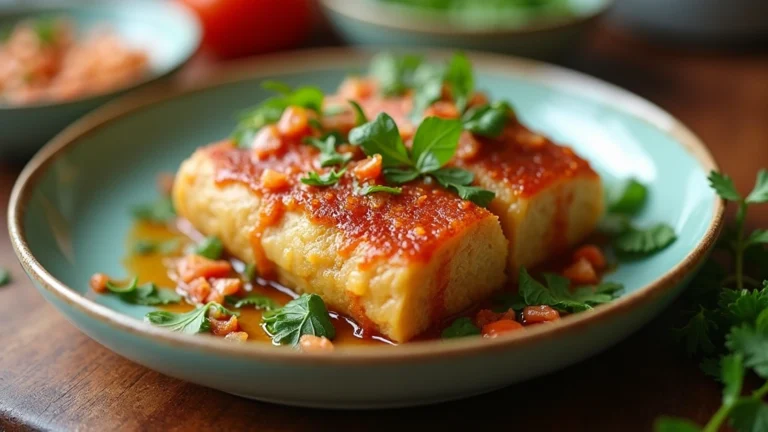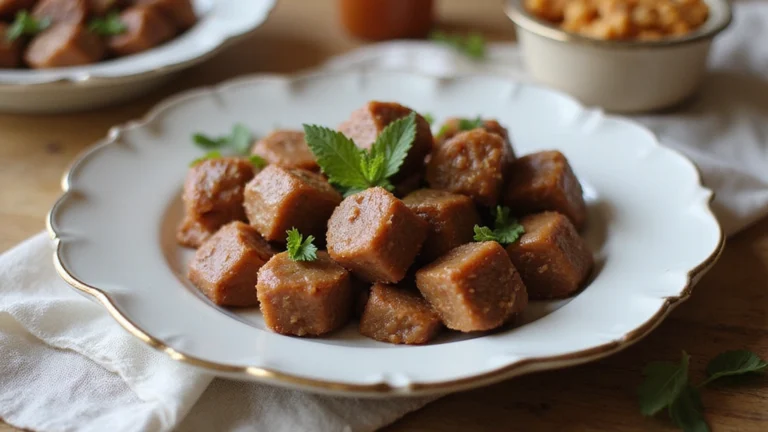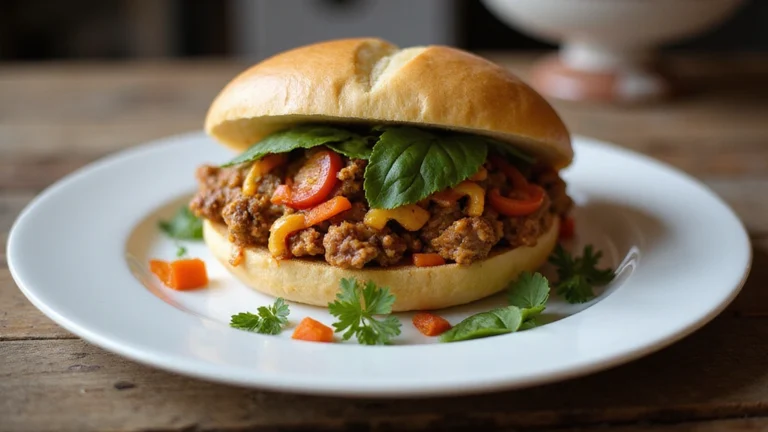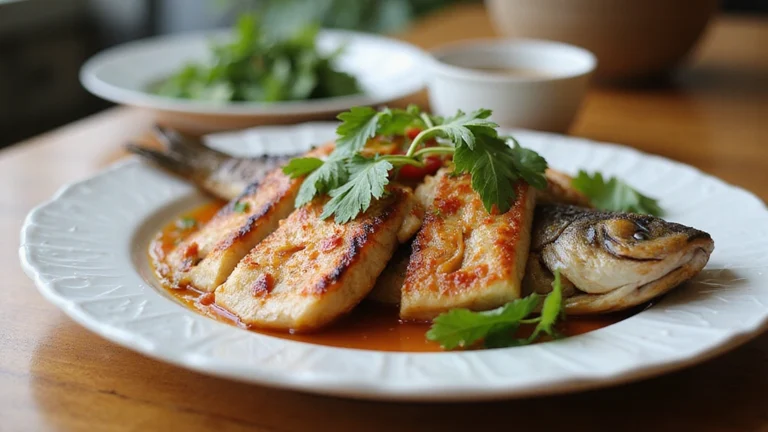
What Are Golubtsy: Traditional Russian Stuffed Cabbage Rolls
Golubtsy represent the heart of Russian comfort food tradition—cabbage leaves carefully wrapped around a hearty filling of ground meat and rice then slowly simmered in a rich tomato sauce. These beloved rolls carry deep cultural significance in Russian households where they’re typically served at family gatherings alongside sour cream for an extra touch of richness.
The name “golubtsy” (голубцы) translates to “little pigeons” in Russian which might seem curious until you understand its historical context. Food historians believe this nickname originated from the way the finished rolls resemble birds at rest with their wings folded. Some regional variations exist across Eastern Europe including Ukrainian holubtsi Polish gołąbki and Romanian sarmale—each adding their unique touch to this fundamental dish.
Traditional golubtsy filling combines ground beef or pork (sometimes a mixture of both) with cooked rice onions carrots and herbs. The proportions typically follow a 2:1 ratio of meat to rice creating the perfect balance of protein and starch. My grandmother always insisted that adding a small amount of finely grated carrot brings necessary moisture and subtle sweetness to the filling—a trick I continue to use in my kitchen today.
Preparing authentic golubtsy requires patience and care starting with softening whole cabbage leaves. The process typically involves blanching or freezing techniques to make the leaves pliable enough for rolling without tearing. Many Russian home cooks including my aunt Natasha swear by a particular method—coring the cabbage and submerging it in boiling water gradually removing the outer leaves as they soften.
The sauce that golubtsy simmer in plays an equally important role in developing their distinctive flavor profile. Traditional recipes call for a simple tomato-based sauce enriched with sautéed onions and sometimes carrots creating a slightly sweet yet savory liquid that permeates the rolls during their long cooking time. This slow cooking process allows the cabbage to absorb the sauce while ensuring the meat filling cooks thoroughly resulting in tender melt-in-your-mouth texture.
While modern adaptations exist including vegetarian versions with mushrooms and grains the classic preparation remains most treasured. Russian families often prepare large batches of golubtsy as they taste even better the next day when flavors have had time to meld together. The dish exemplifies Russian cuisine’s emphasis on nourishing substantial meals designed to provide comfort during long cold winters.
Why You’ll Love This Russian Comfort Food
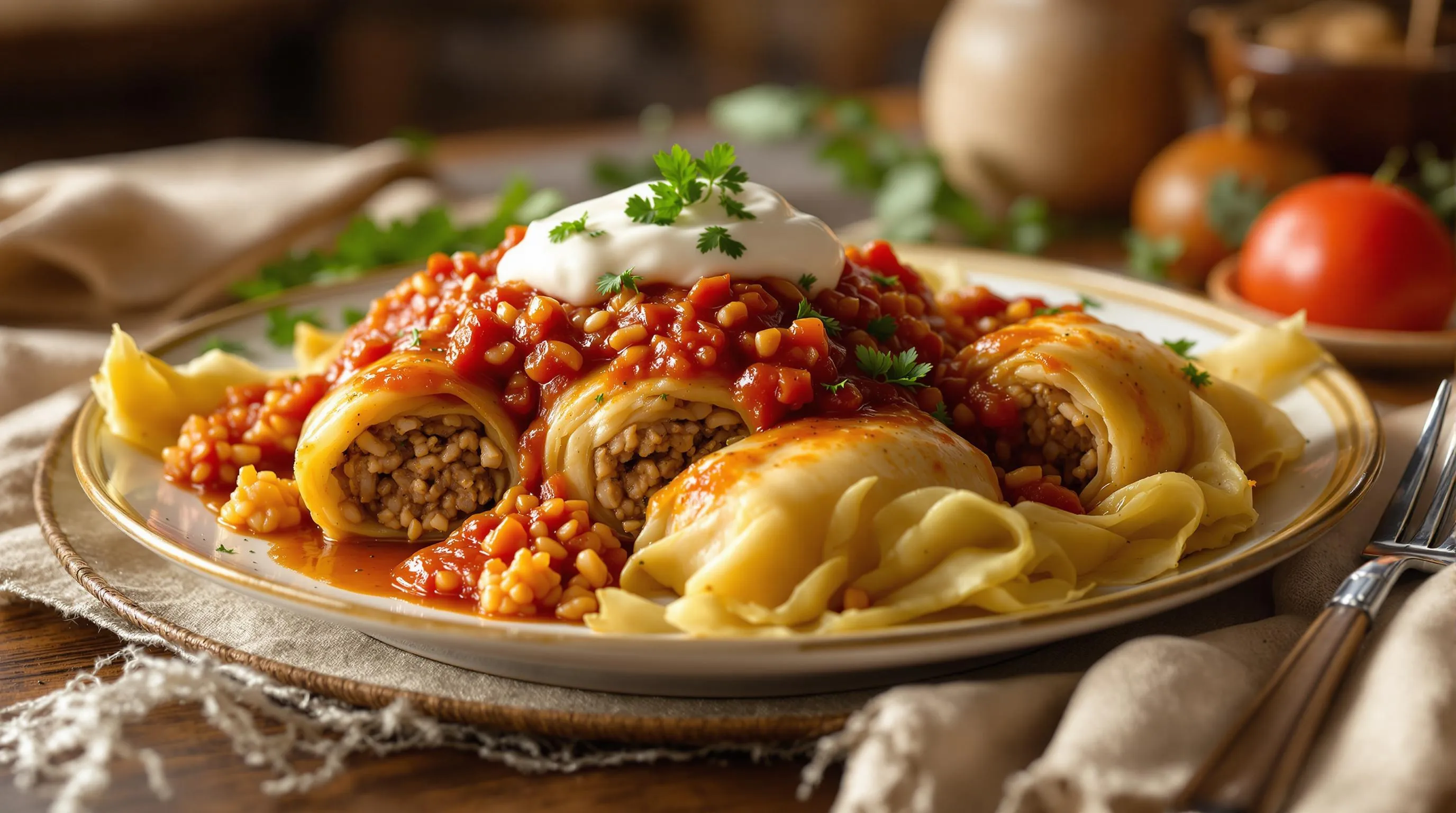
Wholesome and Nutritious
You’ll appreciate how golubtsy offers a perfect balance of lean proteins, whole grains, and vegetables in each bite. This nutritionally complete dish keeps you satisfied long after eating, combining ground meat with rice and wrapped in vitamin-rich cabbage leaves. The traditional recipe delivers protein, fiber, and essential nutrients while maintaining its comforting appeal, making it a guilt-free indulgence even on cold winter evenings.
Incredible Versatility
These cabbage rolls welcome adaptation to suit your dietary preferences and pantry ingredients. Try switching between beef, pork, or turkey as your protein base, or explore vegetarian versions with mushrooms and buckwheat. You can adjust the seasoning profile from the traditional Russian herbs to more adventurous international flavors. The basic technique remains the same while allowing endless personalization options for your family’s tastes.
Make-Ahead Convenience
Your busy schedule will benefit from golubtsy’s excellent make-ahead quality. The flavors actually deepen and improve overnight, making these cabbage rolls taste even better the next day. Prepare a large batch during weekend cooking sessions and enjoy stress-free meals throughout the week. These rolls freeze beautifully for up to three months, providing quick comfort food without additional preparation when you need it most.
Rich Cultural Experience
Eating golubtsy connects you to centuries of Russian culinary tradition with every forkful. This beloved dish appears at family celebrations and holiday tables across Eastern Europe, carrying nostalgic significance for many. The careful preparation and slow cooking process represent the Russian dedication to hearty, soul-warming food that brings people together. Serving golubtsy in your home invites this cultural richness to your own table.
Satisfying Texture Combination
Your palate will delight in the contrasting textures that make golubtsy so satisfying. The tender cabbage wrapper yields to reveal fluffy rice and savory meat within, creating a perfect bite every time. The rich tomato sauce adds another dimension as it seeps into every layer during baking. Finish with a dollop of cool sour cream for temperature and textural contrast that elevates the entire experience to truly crave-worthy status.
Ingredients For Authentic Golubtsy

Creating authentic Russian stuffed cabbage rolls requires simple yet exact ingredients that together produce a hearty and flavorful dish. Each component plays an essential role in developing the traditional taste that has made golubtsy a beloved staple in Russian homes.
For The Cabbage Rolls
- 1 large head of cabbage with leaves intact
- 1 lb (450g) ground beef
- 1 lb (450g) ground pork
- ½ cup (110g) white rice, partially cooked
- 1 medium onion, finely chopped
- 1 large carrot, grated
- 1 stalk celery, finely diced
- 2 tablespoons butter or vegetable oil
- 2 tablespoons fresh dill or parsley, chopped
- 1 teaspoon salt
- ½ teaspoon black pepper
- ½ teaspoon paprika (optional)
The secret to perfect cabbage rolls starts with proper preparation of the cabbage. You should core the cabbage and blanch it in boiling salted water until the leaves become pliable but not mushy. The outer leaves require about 3-5 minutes of blanching while inner leaves need less time. After blanching, carefully peel each leaf and remove the thick central rib to make rolling easier.
Your rice should be cooked until slightly underdone as it will continue cooking inside the rolls. A traditional technique involves finely chopping the small inner cabbage leaves and adding them to your meat mixture for extra flavor and to reduce waste.
For The Tomato Sauce
- 2 cups tomato sauce or passata
- 1 medium onion, finely diced
- 1 large carrot, grated
- 1 tablespoon butter or ghee
- ¼ cup sour cream or crème fraîche (optional)
- 2 bay leaves
- 1 teaspoon sugar
- Salt and pepper to taste
The sauce forms the flavorful base in which your cabbage rolls will simmer to perfection. Begin by sautéing the onions and carrots in butter until they become soft and fragrant. This vegetable base adds depth to the tomato sauce. Many Russian families add a touch of sour cream to create a richer sauce with a pleasant tangy note that balances the acidity of the tomatoes.
Some regional variations include adding a pinch of sugar to balance the acidity or incorporating additional herbs like bay leaves that infuse the sauce with aromatic flavors during the long simmering process. The sauce should be prepared slightly thinner than you might expect as it will thicken while cooking with the cabbage rolls.
Equipment Needed
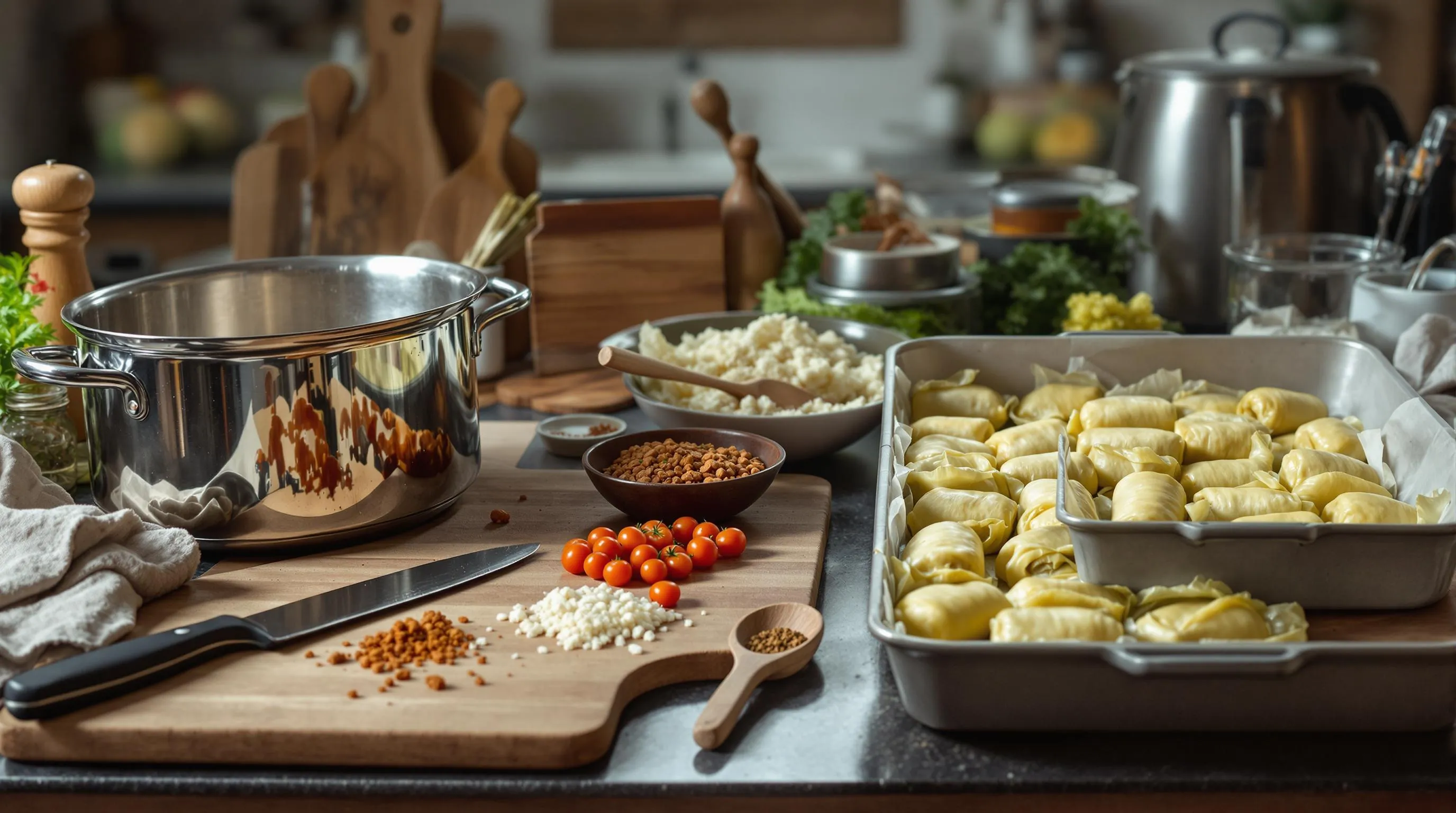
Preparing authentic Golubtsy requires several key kitchen tools to ensure your Russian stuffed cabbage rolls turn out perfectly. Having the right equipment on hand will make the process more efficient and enjoyable.
- Large pot or Dutch oven – Essential for blanching the cabbage leaves; choose one deep enough to fully submerge a head of cabbage
- Sharp knife and cutting board – For coring the cabbage and preparing all ingredients
- Tongs or slotted spoon – To safely remove hot cabbage leaves from boiling water
- Large mixing bowl – For combining ground meat, rice, and seasonings
- Measuring cups and spoons – For accurate ingredient portions
- Skillet or sauté pan – For cooking onions and other vegetables for the filling
- 9×13-inch baking dish – The ideal size for arranging and baking your cabbage rolls
- Aluminum foil – To cover your dish during baking, keeping the rolls moist
- Meat thermometer – Optional but helpful to ensure the meat filling reaches 165°F
- Ladle – For pouring sauce over the arranged cabbage rolls
You might also find a food processor useful for finely chopping vegetables if you prefer a smoother filling texture. Many Russian home cooks swear by using a cast iron Dutch oven for the final baking stage, as it distributes heat evenly and helps develop the rich flavors that make Golubtsy so comforting.
Having these tools organized before you begin will streamline your cooking process and help you create this traditional Russian dish with confidence. Most importantly, prepare a sturdy wooden spoon – you’ll need it for the satisfying task of serving these hearty cabbage rolls to your appreciative dinner guests.
How To Prepare The Cabbage
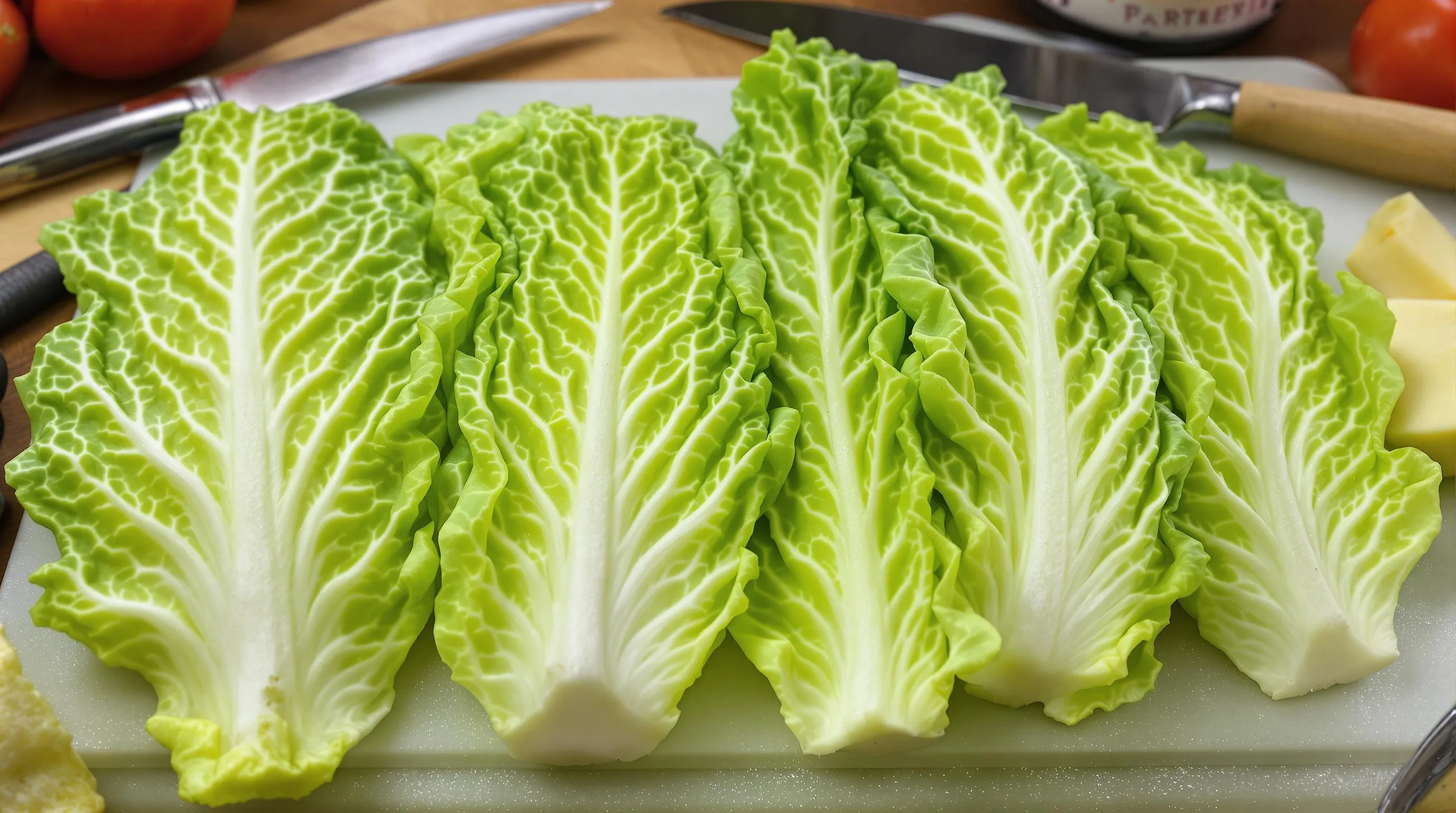
Preparing cabbage leaves properly is perhaps the most crucial step in creating authentic Golubtsy. The goal is to transform crisp cabbage leaves into soft pliable wraps that won’t tear during rolling yet maintain enough structure to hold your filling.
Selecting The Right Cabbage
Choose a medium-sized white cabbage with fresh-looking outer leaves. The ideal cabbage should not be overly ripe or tough. Test the veins by gently pressing your fingernail against them – they should give slightly rather than resist completely. Avoid cabbages with extremely hard thick veins as these will be difficult to work with even after blanching.
Coring The Cabbage
Start by removing the core from your cabbage:
- Place the cabbage on a cutting board with the stem side down
- Using a sharp knife cut a deep cone around the core
- Twist and pull to remove the core completely
- This crucial step helps the leaves separate more easily during blanching
Blanching Method
Blanching softens the leaves while preserving their integrity:
- Fill a large pot with water (enough to fully submerge the cabbage)
- Add 1-2 tablespoons of salt to the water
- Bring the water to a rolling boil
- Submerge the whole cored cabbage in the boiling water
- Allow the cabbage to cook for about 30-60 seconds
- As the outer leaves soften gently peel them off with tongs
- Return the cabbage head to the water and continue removing leaves as they soften
- Transfer removed leaves to a colander to drain and cool
For particularly large cabbages you may find it easier to remove leaves in batches of 2-3 at a time before blanching them separately.
Preparing The Leaves
Once your leaves are blanched and cooled:
- Lay each leaf flat on a cutting board
- Locate the thick center rib at the base of each leaf
- Using a paring knife carefully trim down or remove this thick part
- This trimming makes the leaves much easier to roll without tearing
- Set prepared leaves aside on paper towels to remove excess moisture
Your cabbage leaves are now perfectly prepared for filling with your meat and rice mixture. The blanching process ensures they’re soft enough to roll yet sturdy enough to maintain their shape throughout the cooking process. This careful preparation is what separates exceptional Golubtsy from merely good ones.
Making The Filling
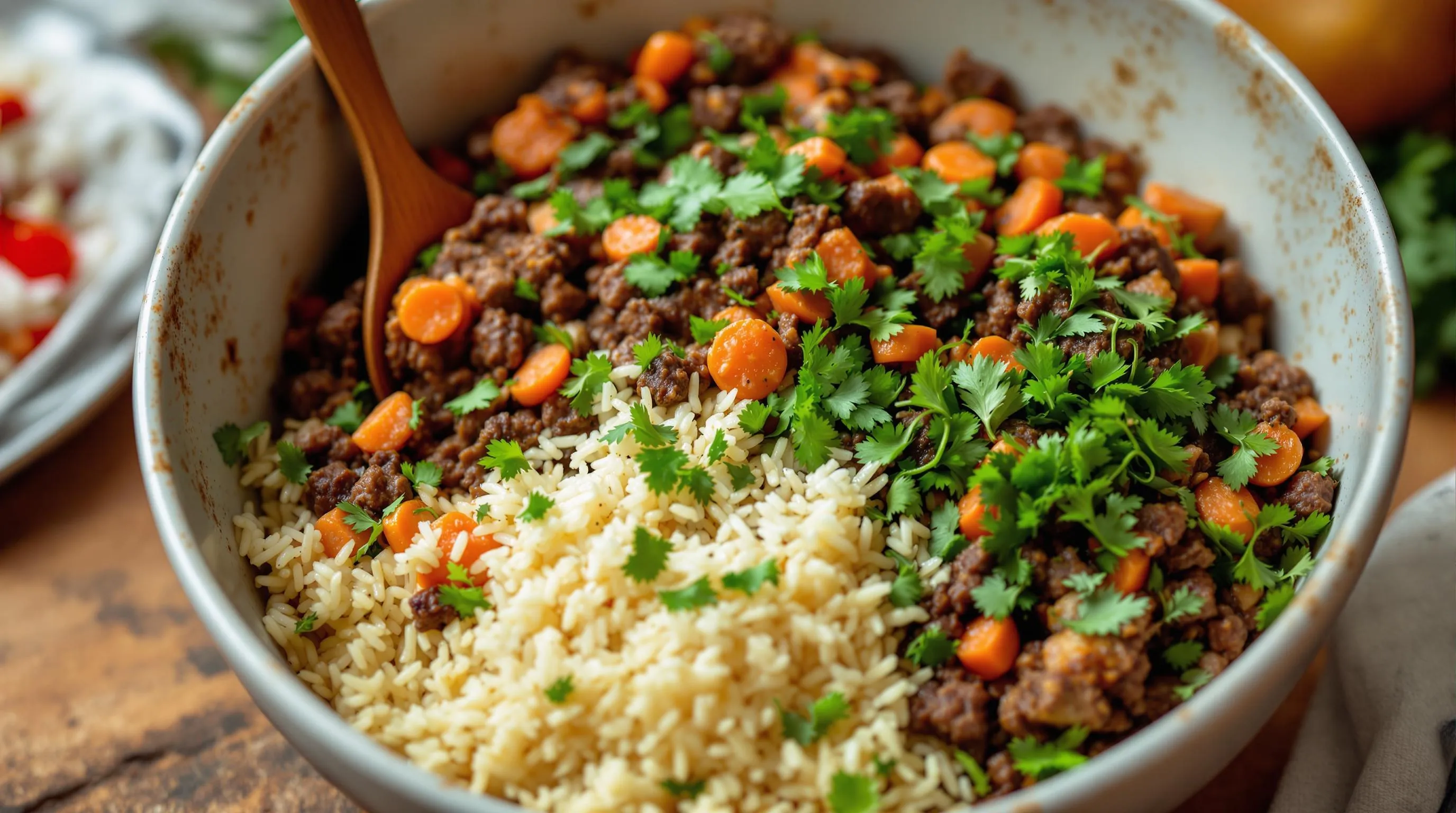
The heart of any perfect Golubtsy lies in its flavorful filling. Creating this savory mixture requires attention to detail and proper technique to achieve the authentic taste that makes these Russian cabbage rolls so beloved.
Start by heating 2 tablespoons of butter or vegetable oil in a large skillet over medium heat. Add 1 large finely chopped onion and 2 medium shredded carrots to the pan. Sauté these vegetables for 7-8 minutes until they become soft and translucent with the onions taking on a slight golden hue. This initial cooking process builds a foundation of sweetness that balances the savory elements of the dish.
In a spacious mixing bowl, combine 1½ pounds of ground beef (or use a combination of beef and veal for a lighter texture). Add the sautéed vegetables to the meat along with 1 cup of cooked rice. The rice should be slightly undercooked as it will continue to soften during the baking process. The traditional ratio follows approximately 2:1 meat to rice proportion for optimal texture and flavor balance.
Season your filling generously with 3 minced garlic cloves, 2 tablespoons of fresh chopped parsley, 1 teaspoon of dried herbs (oregano or thyme work beautifully), 1½ teaspoons of salt, and ½ teaspoon of freshly ground black pepper. For authentic Russian flavor, consider adding ¼ teaspoon of allspice or a pinch of red pepper flakes for subtle warmth.
Mix all ingredients thoroughly but gently using your hands or a wooden spoon. Overmixing can make the filling dense and tough, so combine just until the ingredients are evenly distributed. The mixture should feel moist and hold together when shaped into a ball.
For extra moisture and binding, you might incorporate 1 beaten egg into the mixture. This addition helps the filling maintain its shape inside the cabbage leaves during the cooking process. Some regional variations include adding a splash of tomato sauce directly to the filling for added moisture and flavor cohesion with the final sauce.
Test the seasoning by cooking a small patty of the filling in a pan. This simple step allows you to adjust salt, pepper, or herbs before assembling your Golubtsy. Your filling should taste robust enough to shine through the mild cabbage wrapper.
Let the mixture rest for 10-15 minutes before assembling the rolls. This brief resting period allows the flavors to meld and the rice to absorb some of the moisture from the meat and vegetables, resulting in a more cohesive filling that will maintain its integrity during cooking.
The final filling should be aromatic, moist but not wet, and hold together when scooped. These characteristics ensure your Golubtsy will deliver that perfect balance of textures and flavors that makes this Russian comfort food so satisfying.
How To Assemble Golubtsy

Assembling golubtsy is where your Russian culinary adventure truly begins. This step transforms simple ingredients into elegant rolls that carry centuries of tradition in each bite.
Prepare the Cabbage Leaves
Start by bringing a large pot of water to a boil. Submerge your whole head of cabbage in the boiling water for about 3-5 minutes until the outer leaves soften. Carefully peel off these softened leaves one by one as they become pliable. You may need to return the cabbage to the water several times as you work your way inward. Once removed allow the leaves to cool slightly before handling. Take a sharp paring knife and cut off the thick central rib at the base of each leaf without cutting through the entire leaf. This critical step ensures your cabbage leaves will roll easily without breaking or tearing during the assembly process.
Prepare the Filling
Your filling should be ready with all components properly combined. For authentic golubtsy use a mixture of ground beef and pork (about 1.5 pounds total) blended with approximately 3/4 cup of partially cooked rice. Add your sautéed vegetables including one finely chopped onion and one grated carrot. Season generously with 2-3 minced garlic cloves salt pepper and traditional herbs like dill or parsley. Mix everything thoroughly but gently using your hands until just combined. Avoid overmixing which can make the filling dense and tough. The texture should be cohesive but still light with the rice grains visible throughout the meat mixture.
Rolling Technique
Lay a prepared cabbage leaf flat on your work surface with the cut rib side facing toward you. Place 1-2 tablespoons of your meat and rice filling near the bottom edge of the leaf. The amount will depend on the size of your leaf but avoid overfilling which makes rolling difficult. Fold the bottom edge up over the filling then fold both sides inward toward the center. Roll the leaf upward away from you creating a neat package similar to wrapping a burrito. The cabbage should completely enclose the filling forming a tight cylinder. Place each completed roll seam-side down to prevent unraveling. Your finished golubtsy should be uniform in size ensuring they cook evenly when simmered in the sauce.
Arranging for Cooking
Position your rolled golubtsy seam-side down in a deep heavy-bottomed pot or Dutch oven. Arrange them in a single layer if possible or create multiple layers if needed. Pour your prepared tomato sauce over the rolls ensuring they’re completely covered. The sauce typically combines tomato paste vegetable broth sautéed onions and carrots for rich flavor. For added authenticity layer any remaining chopped cabbage between or around your rolls. This traditional technique prevents burning and adds extra flavor to the dish. Cover the pot with a tight-fitting lid preparing your golubtsy for their final transformation during the simmering process.
Checking for Proper Assembly
Before you begin cooking inspect your assembled golubtsy for any potential issues. Each roll should be tightly sealed with no filling escaping from the sides. The seam should rest against the bottom of your cooking vessel to prevent unraveling during the cooking process. Your rolls should be similar in size ensuring even cooking throughout. Make any necessary adjustments by rewrapping loose rolls or redistributing filling between rolls that appear uneven. This attention to detail during assembly guarantees perfectly cooked golubtsy with the ideal balance of tender cabbage and savory filling in every bite.
Cooking Methods
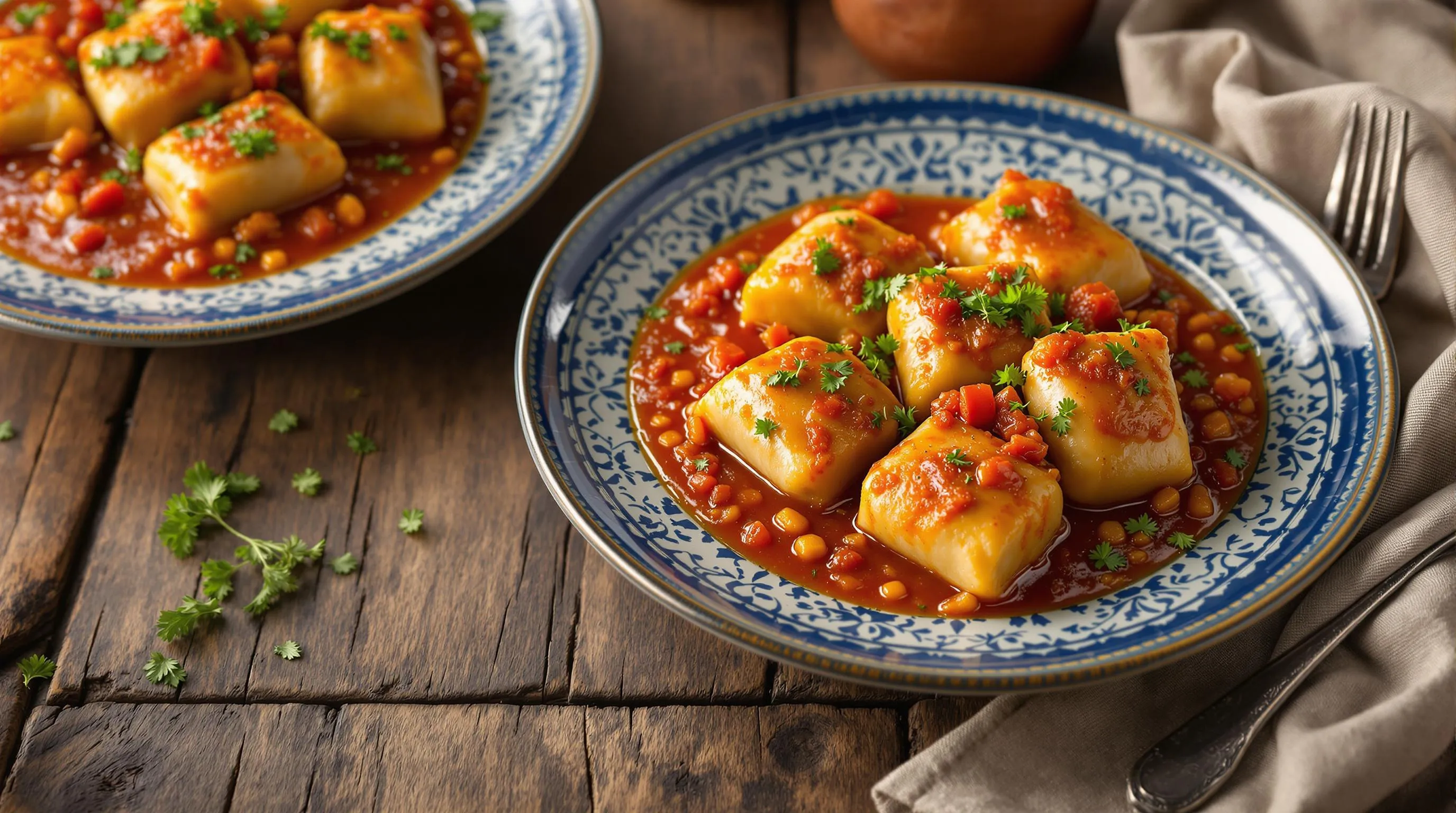
Traditional Russian Golubtsy can be prepared using two primary cooking techniques, each imparting unique flavors and textures to this beloved dish. Both methods start with the same preparation steps but differ in their final cooking approach.
Stovetop Method
The stovetop method represents the most traditional approach to cooking Golubtsy. Begin by placing your assembled cabbage rolls seam-side down in a large Dutch oven or heavy-bottomed pot. Pour your prepared tomato sauce over the rolls, ensuring they’re completely covered. The sauce should reach about three-quarters of the way up the sides of the rolls. Add any remaining chopped cabbage from the core as a flavor-improving layer on top of your rolls. Bring the mixture to a gentle simmer over medium heat, then reduce to low, cover tightly, and cook for approximately 45-60 minutes. During this time, the flavors meld beautifully as the cabbage softens further and the filling cooks through. Test for doneness by inserting a meat thermometer into the center of a roll – it should register 165°F (74°C). The stovetop method produces exceptionally tender rolls with a rich, concentrated sauce that permeates the cabbage leaves.
Oven-Baked Method
Oven-baking offers a more hands-off approach that many home cooks prefer. Arrange your prepared cabbage rolls seam-side down in a 9×13-inch baking dish, placing them snugly but not overcrowded. Pour your tomato sauce mixture evenly over the rolls, making sure to coat them thoroughly. For extra richness, mix 1/2 cup of sour cream or crème fraîche into your sauce before pouring. Cover the baking dish tightly with aluminum foil to trap moisture and prevent the rolls from drying out. Bake at 325°F (160°C) for approximately 1.5 hours until the filling is completely cooked and the cabbage is perfectly tender. The oven method creates a wonderful caramelization in the sauce and allows the flavors to develop deeply while requiring minimal attention during cooking. This technique works particularly well when preparing larger batches for family gatherings or when you want to free up stovetop space for other dishes.
Serving Suggestions
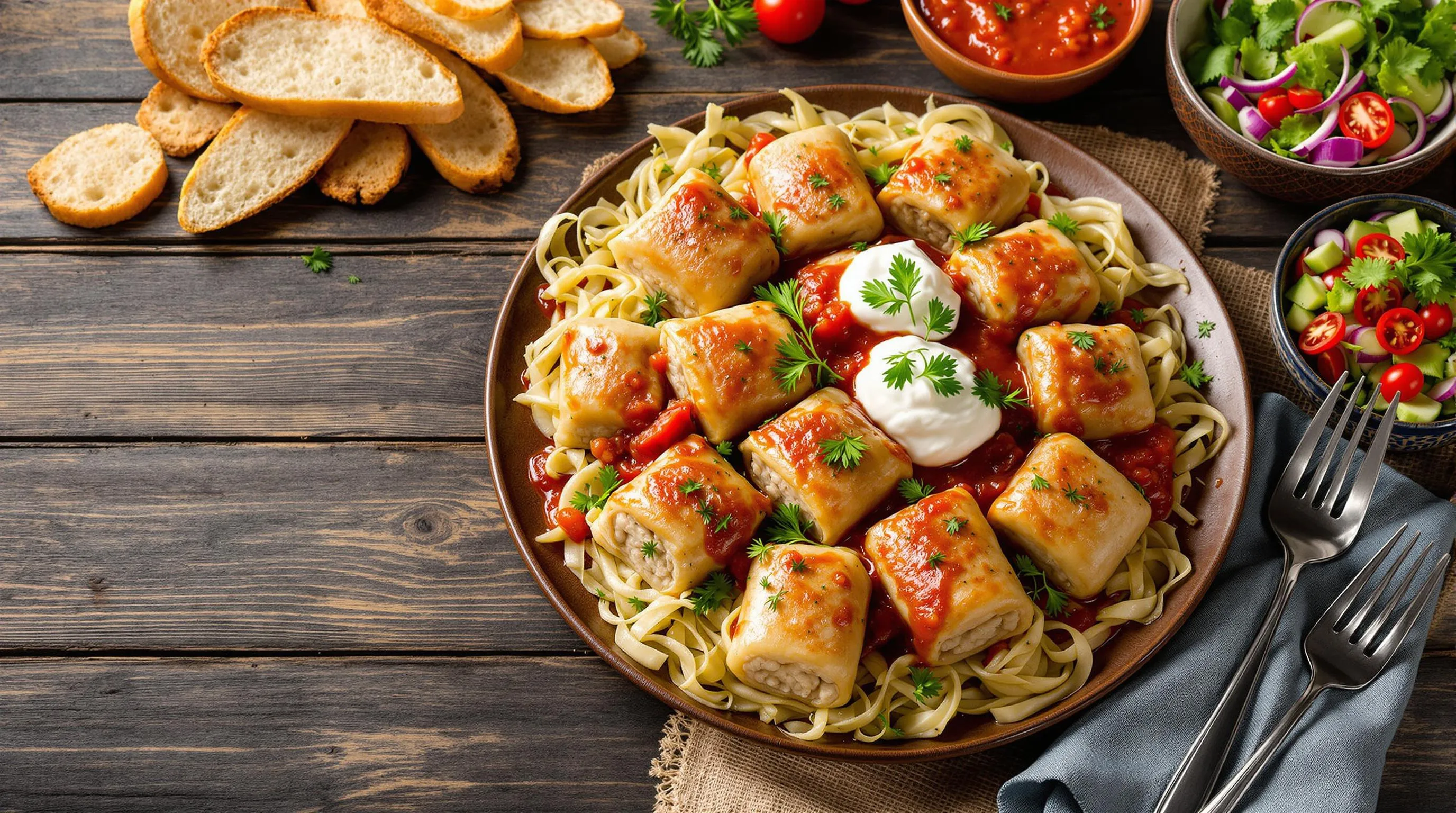
Golubtsy shine brightest when served piping hot from the oven or stovetop. Present these hearty cabbage rolls on a large platter or individual plates with a generous spoonful of the rich tomato sauce ladled over the top. Fresh herbs like dill or parsley make an excellent garnish adding vibrant color and a touch of freshness to this rustic dish.
A dollop of sour cream is absolutely essential when serving traditional Golubtsy. The cool creaminess perfectly balances the savory warmth of the cabbage rolls creating that authentic Russian dining experience. For those following a plant-based diet vegan sour cream offers a delicious alternative that maintains the traditional flavor profile.
Pair your Golubtsy with simple sides that complement rather than compete with these flavorful rolls. Creamy mashed potatoes make an ideal accompaniment absorbing the delicious tomato sauce and creating a truly comforting meal. Crusty bread works wonderfully too for sopping up every last bit of the flavorful sauce.
Consider serving these cabbage rolls with a crisp garden salad dressed simply with lemon juice and olive oil to balance the richness of the main dish. The bright acidic notes cut through the hearty flavors providing a refreshing contrast to each bite.
Storage options for leftover Golubtsy are quite practical. These cabbage rolls actually improve in flavor after a day in the refrigerator where they can be safely stored for up to 4 days. For longer preservation freeze the cooled rolls in airtight containers for up to 3 months reheating them gently in the oven when ready to enjoy again.
For special occasions arrange your Golubtsy on a decorative platter surrounded by roasted vegetables and garnished with fresh herbs. This presentation elevates the humble cabbage roll to a centerpiece worthy of celebration reflecting its important place in Russian culinary tradition.
Golubtsy serve as a complete meal on their own but can be incorporated into a larger Russian-themed feast alongside other traditional dishes like borscht or vinegret salad. This approach introduces diners to the diverse and rich flavors of Russian cuisine creating a memorable cultural dining experience.
Storage And Reheating
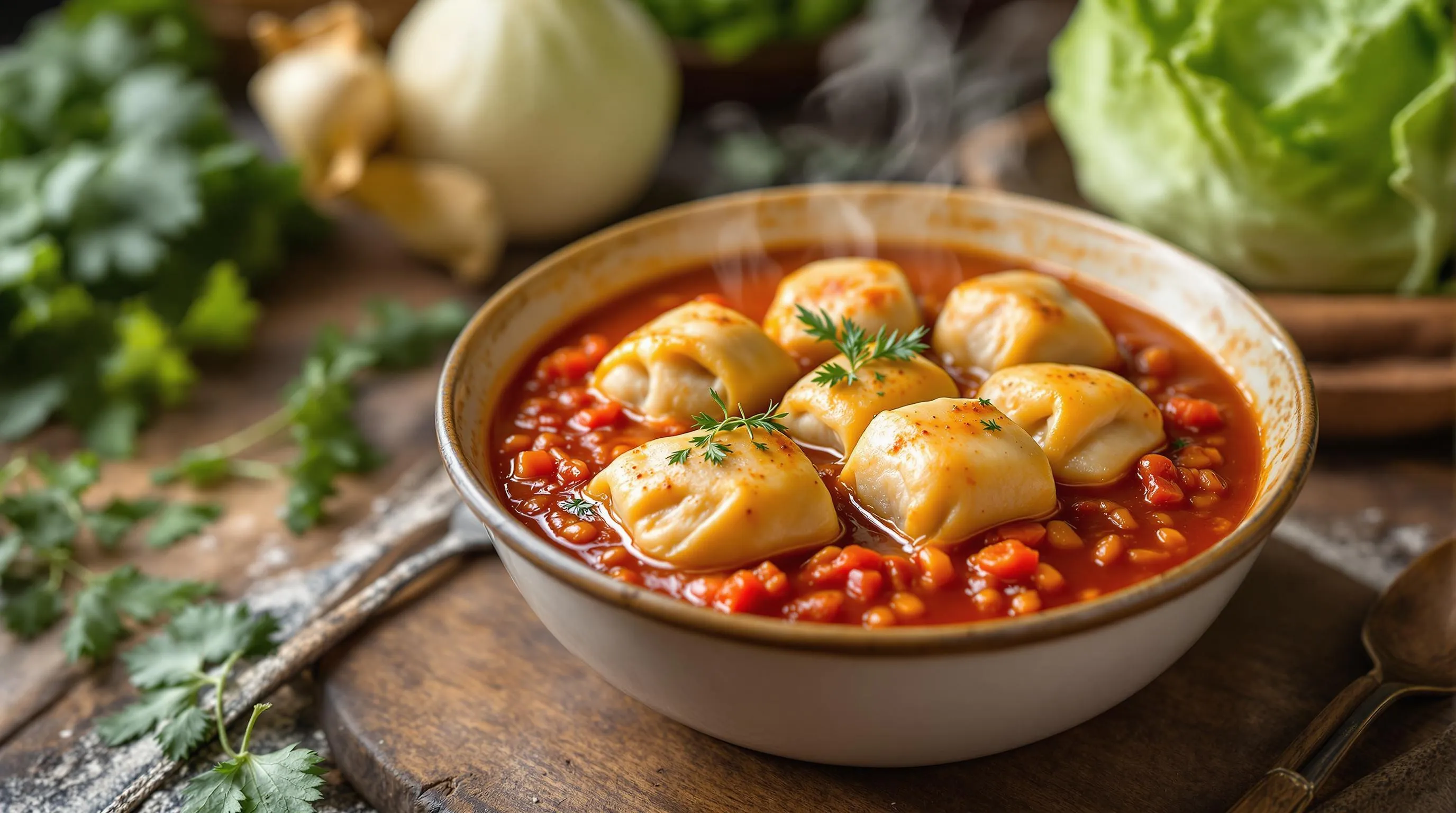
Golubtsy taste even better the next day when all the flavors have had time to meld together. Proper storage ensures you can enjoy these Russian cabbage rolls for days or even months after preparation.
Refrigerating Leftovers
Store your leftover Golubtsy in an airtight container in the refrigerator for optimal freshness. These delicious cabbage rolls will remain tasty and safe to eat for 4 to 5 days when properly refrigerated. The tomato sauce actually continues to develop its flavor during storage making day-two Golubtsy particularly delicious.
Freezing Instructions
Golubtsy freeze exceptionally well making them perfect for meal prep. For cooked cabbage rolls place them along with the sauce in freezer-safe containers or heavy-duty ziplock bags. They will maintain their quality for 3 to 6 months in the freezer. Always label your containers with the date to keep track of freshness.
You can also freeze uncooked Golubtsy for future meals. Simply assemble the rolls place them in a freezer-safe baking dish or freezer bags and store them for up to 3 months. Remember that uncooked rolls must be completely thawed in the refrigerator overnight before cooking never cook them from frozen.
Reheating Methods
To reheat refrigerated Golubtsy simply warm them in a covered skillet over medium-low heat until heated through. Add a splash of water or broth if the sauce seems too thick.
For frozen Golubtsy thaw them overnight in the refrigerator first. Once thawed reheat them in an oven preheated to 350°F (175°C) for 30-40 minutes until they’re bubbling hot. Cover the baking dish with foil to prevent the rolls from drying out.
Alternatively you can reheat thawed Golubtsy on the stovetop in a covered pot over medium-low heat stirring the sauce occasionally until the rolls are heated through about 15-20 minutes.
| Storage Type | Duration | Notes |
|---|---|---|
| Refrigerated (cooked) | 4-5 days | Store in airtight container |
| Frozen (cooked) | 3-6 months | Freeze with sauce; thaw overnight |
| Frozen (uncooked) | 1-3 months | Defrost fully in refrigerator before cooking |
The remarkable keeping quality of Golubtsy makes them an excellent option for busy households. Many Russian families traditionally prepare large batches specifically to enjoy throughout the week or to have ready meals during winter months.
Make-Ahead Tips
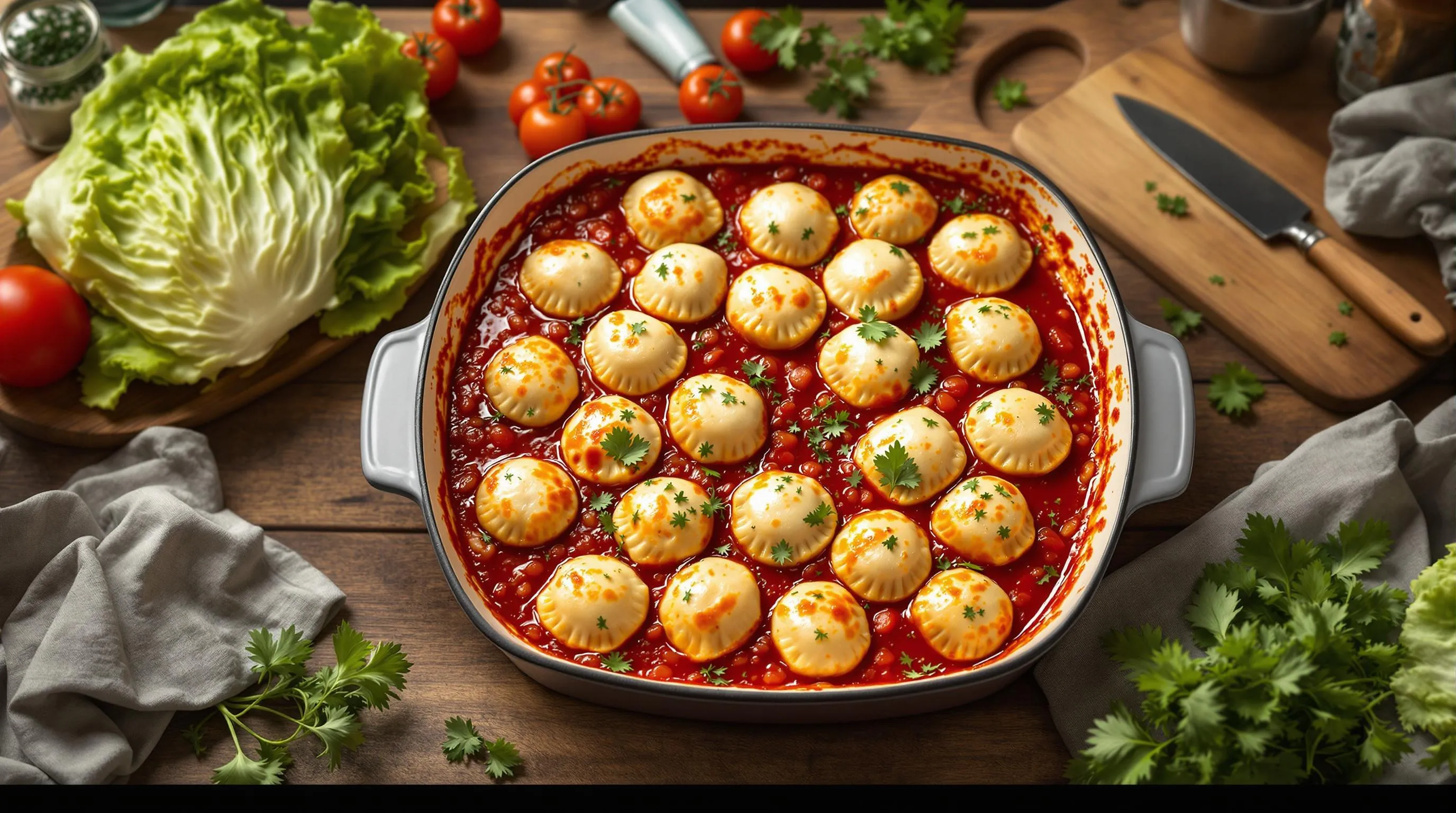
Golubtsy shines as one of those rare dishes that actually improves with time, making it perfect for advance preparation. You can prepare these Russian cabbage rolls up to three days before serving, allowing the flavors to develop and deepen while sitting in the refrigerator. Many Russian home cooks intentionally make Golubtsy a day ahead specifically for this flavor-improving effect.
For efficient meal planning, consider assembling the cabbage rolls completely but stopping short of the final cooking. Store these assembled rolls in your refrigerator, covered tightly with plastic wrap, for up to 24 hours. When ready to serve, simply pour the tomato sauce over them and proceed with the normal cooking process.
The tomato sauce can be prepared separately up to five days in advance and kept refrigerated in an airtight container. This approach breaks down the preparation into manageable steps, perfect for busy weeknights or when hosting dinner parties.
Freezing offers another excellent make-ahead option for Golubtsy. You can freeze the rolls either before or after cooking:
- Uncooked rolls: Arrange assembled rolls on a parchment-lined baking sheet and freeze until solid. Transfer to freezer bags and store for up to 3 months. When ready to cook, thaw overnight in the refrigerator before proceeding with your preferred cooking method.
- Cooked rolls: Allow the Golubtsy to cool completely after cooking. Portion them into meal-sized containers with some sauce and freeze for up to 6 months. Thaw overnight in the refrigerator before reheating.
For the best texture when making ahead, slightly undercook the cabbage rolls if you plan to reheat them later. This prevents them from becoming overly soft during the reheating process.
Traditional Russian families often prepare large batches of Golubtsy during weekend cooking sessions, then enjoy them throughout the week. This practice embodies the practical wisdom of Russian cuisine, which values dishes that can sustain a family through busy times and cold winter days.
My Grandmother’s Secrets For Perfect Golubtsy
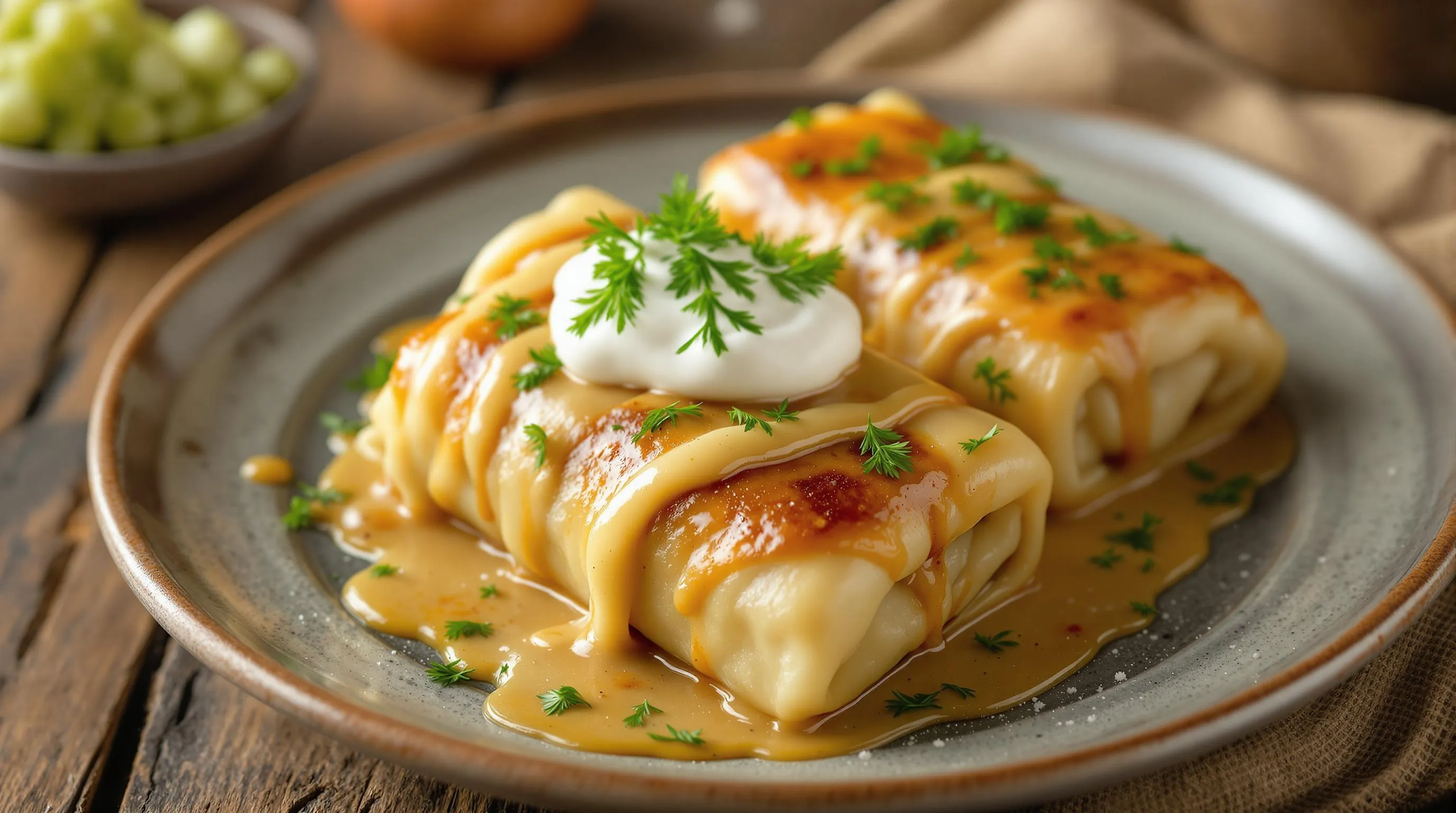
My grandmother Natasha always said the difference between good golubtsy and extraordinary golubtsy lies in the details. Throughout decades of perfecting her recipe in our small kitchen near Moscow she developed techniques that transformed this humble dish into something truly special.
The quality of cabbage matters tremendously according to Babushka. She always selected young fresh cabbage heads with tender pliable leaves. Before removing the core she would carefully freeze the whole cabbage overnight then thaw it completely which eliminated the need for blanching while maintaining the leaves’ integrity.
Her filling followed the traditional 2:1 ratio of meat to rice but with a twist. Grandmother insisted on using a mixture of ground beef and pork for richness while keeping the rice slightly undercooked. “The rice will finish cooking inside the rolls absorbing all those wonderful juices” she would explain while mixing the ingredients by hand rather than with utensils to better feel the texture.
Perhaps her most distinctive secret involved the sauce. While most recipes call for a simple tomato base Babushka enhanced hers with a tablespoon of creme fraiche and a small amount of sugar to balance the acidity. She also added a knob of butter right before serving which created a velvety richness that coated each bite perfectly.
The cooking method itself required patience. “Never rush golubtsy” she would warn as she placed the carefully rolled bundles into her old cast iron Dutch oven. She always baked them covered at a low temperature (325°F) for at least 90 minutes then uncovered for the final 15 minutes to allow the tops to caramelize slightly.
Resting time proved crucial in her method. Grandmother always prepared golubtsy a day ahead allowing the flavors to meld overnight in the refrigerator. “The true flavor comes on the second day” she insisted while reheating them slowly on the stovetop with additional sauce if needed.
Her final touch involved serving. Each plate received exactly two rolls with plenty of sauce spooned over them and a generous dollop of sour cream on top. Fresh dill sprinkled just before serving provided the perfect aromatic finish to complete this labor of love that connected generations of our family through food.
Conclusion
Golubtsy stands as a testament to Russian culinary tradition – a dish that transforms simple ingredients into something truly extraordinary. With each bite you taste generations of wisdom passed down through family kitchens.
These cabbage parcels reward your patience with unmatched comfort and flavor. Whether you follow Grandma Natasha’s freezing technique or opt for the traditional blanching method your efforts will yield delicious results.
Beyond its incredible taste Golubtsy offers practicality for modern life. Make it ahead freeze portions or enjoy leftovers that taste even better the next day. As you master this dish you’re not just preparing food – you’re connecting with a rich cultural heritage that continues to bring families together around dinner tables worldwide.
